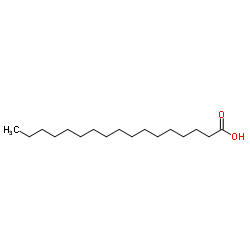Margaric acid

Margaric acid structure
|
Common Name | Margaric acid | ||
|---|---|---|---|---|
| CAS Number | 506-12-7 | Molecular Weight | 270.451 | |
| Density | 0.9±0.1 g/cm3 | Boiling Point | 298.5±0.0 °C at 760 mmHg | |
| Molecular Formula | C17H34O2 | Melting Point | 59-61 °C(lit.) | |
| MSDS | Chinese USA | Flash Point | 158.4±12.5 °C | |
|
Lipid production in the under-characterized oleaginous yeasts, Rhodosporidium babjevae and Rhodosporidium diobovatum, from biodiesel-derived waste glycerol.
Bioresour. Technol. 185 , 49-55, (2015) The growth, lipid production, and carbon use efficiency of two oleaginous yeasts, Rhodosporidium babjevae and Rhodosporidium diobovatum, were compared under nitrogen-limiting conditions with glycerol as the carbon source. Final biomass concentrations of R. ba... |
|
|
An integrated process for microalgae harvesting and cell disruption by the use of ferric ions.
Bioresour. Technol. 191 , 469-74, (2015) In this study, a simultaneous process of harvesting biomass and extracting crude bio-oil was attempted from wet microalgae biomass using FeCl3 and Fe2(SO4)3 as both coagulant and cell-disrupting agent. A culture solution of Chlorella sp. KR-1 was firstly conc... |
|
|
Structural insights into methanol-stable variants of lipase T6 from Geobacillus stearothermophilus.
Appl. Microbiol. Biotechnol. 99 , 9449-61, (2015) Enzymatic production of biodiesel by transesterification of triglycerides and alcohol, catalyzed by lipases, offers an environmentally friendly and efficient alternative to the chemically catalyzed process while using low-grade feedstocks. Methanol is utilize... |
|
|
Determination of free fatty acids in human serum by HPLC with fluorescence detection.
J. Chromatogr. Sci. 53 , 537-41, (2015) It has been suggested that serum concentrations of polyunsaturated essential fatty acids correlate with the symptoms or severity of various diseases, including depression and Alzheimer-type dementia, and that determination of serum fatty acids might be import... |
|
|
Disruption of sphingolipid metabolism augments ceramide-induced autophagy in preeclampsia.
Autophagy 11 , 653-69, (2015) Bioactive sphingolipids including ceramides are involved in a variety of pathophysiological processes by regulating cell death and survival. The objective of the current study was to examine ceramide metabolism in preeclampsia, a serious disorder of pregnancy... |
|
|
The human serum metabolome.
PLoS ONE 6(2) , e16957, (2011) Continuing improvements in analytical technology along with an increased interest in performing comprehensive, quantitative metabolic profiling, is leading to increased interest pressures within the metabolomics community to develop centralized metabolite ref... |
|
|
Metabolomic profiles delineate potential role for sarcosine in prostate cancer progression.
Nature 457(7231) , 910-4, (2009) Multiple, complex molecular events characterize cancer development and progression. Deciphering the molecular networks that distinguish organ-confined disease from metastatic disease may lead to the identification of critical biomarkers for cancer invasion an... |
|
|
Serum and adipose tissue amino acid homeostasis in the metabolically healthy obese.
J. Proteome Res. 13(7) , 3455-66, (2014) A subgroup of obese individuals, referred to as metabolically healthy obese (MHO), have preserved insulin sensitivity and a normal lipid profile despite being obese. The molecular basis for this improved cardiometabolic profile remains unclear. Our objective ... |
|
|
Metabolomic method: UPLC-q-ToF polar and non-polar metabolites in the healthy rat cerebellum using an in-vial dual extraction.
PLoS ONE 10(4) , e0122883, (2015) Unbiased metabolomic analysis of biological samples is a powerful and increasingly commonly utilised tool, especially for the analysis of bio-fluids to identify candidate biomarkers. To date however only a small number of metabolomic studies have been applied... |
|
|
Plasma capric acid concentrations in healthy subjects determined by high-performance liquid chromatography.
Ann. Clin. Biochem. 52 , 588-96, (2015) Capric acid (FA10:0, decanoic acid) is a medium-chain fatty acid abundant in tropical oils such as coconut oil, whereas small amounts are present in milk of goat, cow, and human. Orally ingested FA10:0 is transported to the liver and quickly burnt within it. ... |